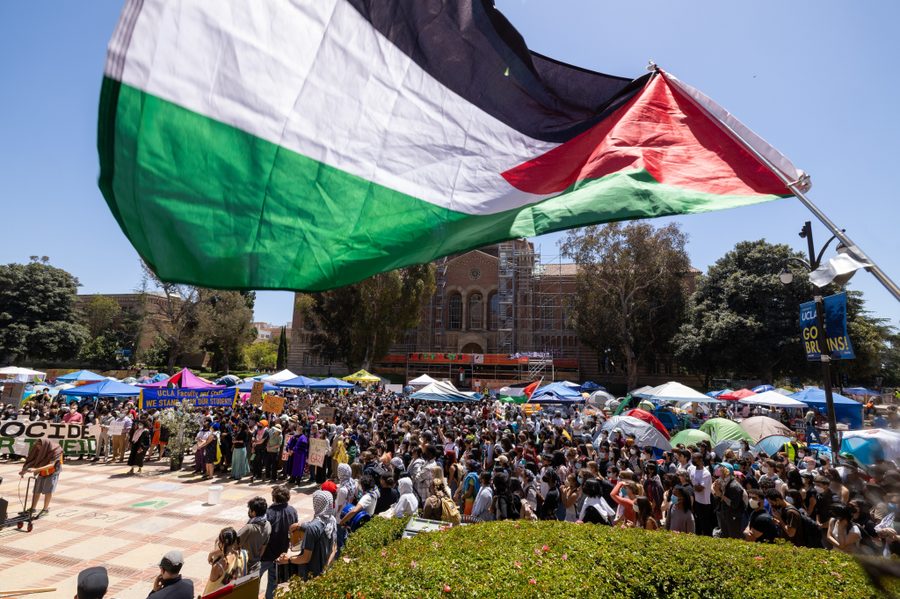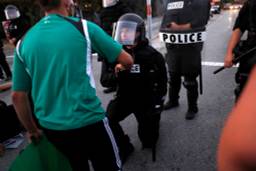Unable to Defend Biden’s Gaza Policy on Its Merits, Elite Pundits Turn to Anti-Zoomer Psychobabble
According to mainstream commentators, kids these days are opposing U.S.-backed mass killing because of Chinese psyops, rigid groupthink and social contagion.
Adam Johnson

The Israeli military is escalating the destruction of Gaza with its invasion of Rafah, while anti-war protesters on college campuses are refusing to be deterred by mass arrests and expulsions. Elite U.S. pundits, meanwhile, are scrambling to defend the status quo and the Biden administration’s continued support for Israel’s assault. The protests, in the eyes of these commentators, simply Look Bad for Democrats leading up to the 2024 election, and they must be dealt with accordingly — both with the baton and in the court of public opinion.
Given the raw carnage from Gaza streaming across social media timelines on a daily basis, and the near-universal condemnation of Israel’s bombing, siege and wholesale destruction of Gaza, few in American mainstream media are willing — or able — to defend the U.S.-backed slaughter on its merits. So instead, establishment pundits are doing the next best thing: pathologizing those protesting what the International Court of Justice calls “plausible genocide.” Debating the substance of the protesters’ simple and clear demands for divestment and a lasting ceasefire is messy, morally awkward and makes President Biden look bad in an election year.

Polling shows that the majority of Americans disagree with Biden’s Gaza policy. So, defenders of the White House have resorted to a torrent of meta-takes. These include Process Concerns (I agree with the protests, but they’re doing it wrong); Front Row Kid Legal Formalism (Technically, camping on university grass is illegal); Bad Faith Claims of “Safety” or “Security” (Whose? Where?); Feigned Confusion (What’s going on? I can’t read protest signs. What are words really?); and the most popular genre in this meta-discourse: Anti-Zoomer Psychobabble.
This approach typically manifests in three ways. Pundits accuse, or heavily imply, that student protesters are under the spell of (1) a Chinese-fueled TikTok psy-op, (2) rigid groupthink defined by binary thinking, (3) social contagion (they’re protesting because it’s cool) or (4) some combination thereof.
When tasked with disparaging and belittling a mass protest movement opposing the killing of more than 15,000 children, pundits are turning to criticism of a tried-and-true punching bag: Kids These Days.
Cue our media’s most mediocre minds to step in and ask what’s driving today’s youth to risk their careers and futures on the cause of Gaza. Clearly, it can’t be because they are rational, moral agents who simply see evil behavior and wish to stop it. No, the real reason must be because they have brain problems.
It’s a psy-op
First up is the widespread idea in elite circles that Kids These Days are strongly opposed to the mass killing in Gaza because they are absorbing a sensationalist, un-nuanced view of the Israeli assault through social media — namely the popular app TikTok which, we are told, is part of a Chinese psychological warfare operation to radicalize our youth. This conventional wisdom was recently echoed by Sen. Mitt Romney (R-Utah) in conversation with Secretary of State Antony Blinken during a panel last Friday at the McCain Institute in Washington, D.C. When asked by Romney about the White House and Israel’s PR problem over Gaza, Blinken said today’s anti-war protesters were “on an intravenous feed of information with new impulses, inputs every millisecond.”
“And of course the way this has played out on social media has dominated the narrative,” Blinken said. When Romney followed up by suggesting that banning TikTok would quell much of the discontent over Gaza, Blinken seemed to agree, telling the senator: “Look, everyone in this room knows there’s a long story here. We were talking about TikTok. Not a story you hear on TikTok.”
This argument that social media is somehow poisoning the minds of the youth has been advanced by everyone from Sens. John Fetterman (D-Pa.), Mark Warner (D-Va.) and Marco Rubio (R-Fla.) to talk show host Bill Maher and the pro-Israel lobbyist Jonathan Greenblatt of the Anti-Defamation League.
The problem is groupthink
An equally popular argument is that Kids These Days are uniquely suffering from rigid groupthink, defined by shallow and binary moral thinking. Wall Street Journal columnist, East Coast cocktail party mainstay and former Ronald Reagan speechwriter Peggy Noonan expressed this view in her May 2 column.
“Young people like to be part of something big and passionate. They want to be part of history,” Noonan writes with her patented sneering tone. “They want to care. It’s romantic to be a revolutionary and pleasurable to claim fierce commitments. It’s good to show you’re a force in the world, that you’ll march for the right and moral thing. Critical thinking isn’t your strong suit, emotion is.”
Atlantic writer and infamous liberal Iraq War-booster George Packer, discussing not college campus protesters, but newer, younger writers who were pushing PEN America to take a stand opposing the ongoing genocide in Gaza (just as PEN America took a stand clearly opposing the Russian invasion of Ukraine), echoed a similar complaint last week. Packer insisted that today’s war protesters are embracing an “authoritarian spirit,” whatever this means. “In practice, they turn out to be no more able to resist the authoritarian spirit than most other people — maybe less. In the Soviet Union, many writers denounced their imprisoned friends without being told to. Here, they check their social-media traffic first.” The piece would go on to list off routine gripes about strident, overly hostile pro-Palestinian zoomers.
In January, writing about widespread outrage over Gaza, the Washington Post’s Amanda Ripley lamented the rise of what “psychologists call ‘splitting.’” “Humans carve the world cleanly in two when they feel threatened,” Ripley writes. “There’s a right and a wrong, a good and an evil, an us and a them. In normal times, this behavior is most obvious in people with serious depression or borderline personality disorder.”
“Students,” Ripley tells us, are a driver of this phenomenon of splitting the world into good and evil. “Americans more than 5,000 miles away” were too quick to condemn those who refuse to condemn the killing in Gaza.
Frank Bruni, who is currently promoting a book with the painfully trite thesis that American politics is defined by extremes trafficking in grievance politics, joined CNN’s Abby Phillip for a smug rundown, using the same type of ad hoc psychoanalysis.
“The death of nuance, the death of complexity,” a ponderous Bruni explained to Phillip of what the campus protests represent. “It’s one of the things that is really thrusting this country into a kind of dysfunction when it comes to civic discourse, when it comes to political debate, that I think is really dangerous.”
Phillip, no doubt fully aware of CNN’s broader pro-Israel editorial line, nodded in agreement, spouting off cliche after cliche about complexity and allowing for disagreement.
Missing from all of these analyses is, of course, the moral content of the protests themselves. To Bruni, bombing and sieging a largely refugee population of 2.2 million people, cutting off their water, fuel, food and electricity, is not a dangerous or extreme position. But opposing these acts of war in too strident or rude of a fashion apparently is.
Wait, it’s social contagion
A corollary to the Rigid Groupthink analysis is the idea that people protest to be cool — to see and to be seen. Like wearing baggy sweatpants or being gender fluid, we are told, protesting genocide in Gaza is simply in right now. Cornell University PhD candidate and writer Philippe Lemoine opined on this explanation last week, writing “my basic model of student protests is that in general students don’t know shit about what they’re protesting against, they do it because it’s cool, makes them feel like they’re part of something important and they want to be with their friends.”
Popular pundit and author Nate Silver concurred, tweeting, “Most people don’t form political opinions through deep examination of the issues or reasoning from first principles. It’s more like picking some particular fashion label or way of dressing. Especially for younger people, who face more peer pressure.”
Amanda Taub of the New York Times advanced a variation of the Cool Kids argument, replacing the pop psychology of Silver for a pop sociology about social contagion. In her pseudo-empirical analysis of the spread of campus protests, “Why Gaza Protests on U.S. College Campuses Have Become So Contagious,” Taub insists the spread is driven by what political scientist Omar Wasow calls an “ovation model.”
Wasow argued that Gaza protests are like a theater audience: “If some people in the front stand up, then other people start to stand up, and it’s a cascade through the auditorium.”
While every protest movement, of course, has social elements, this doesn’t explain why Zoomers are mass protesting the genocide in Gaza rather than demanding better zoning laws or an increase to the capital gains tax. There is an urgent moral appeal to the topic at hand, and ignoring it serves no purpose other than pathologizing — and thus belittling — the demands of the student protesters.
That American youth could be motivated by a clear and obvious moral cause — opposing actions done with their tax dollars, in their name, by a Democratic president who ostensibly represents them and their generation — is out of the question. This is what makes elite U.S. media’s meltdown over “radical” Kids These Days so cynical. The protesters—and a majority of those aged 18 to 29—are consistently on the side of the overwhelming global consensus. The United States, its older populations, and its elites have the fringe position. Ninety-five percent of countries on Earth don’t vote with the United States and its handful of allies against ending the bombing and siege of Gaza. Virtually every human rights group and public health group from OxFam to Amnesty International to 18 UN agencies back a long term ceasefire. It’s the White House that is radical and hard-line. It’s older voters and U.S. pundits that have an extremist and ideological position. It only seems normal because they live in a bubble of war crime denial, venality and chauvinism.
But it’s not normal. If anyone is being subject to undue propaganda, it’s the American pundit class that only reads each other, that flows in and out of cocktail parties with the very people behind the leveling of Gaza. If any cohort is under the spell of rigid ideology, it’s those milling about the greenrooms of CNN, drowning in their own unchecked racist assumption about Palestinian calls for liberation.
If any group desires to be cool and please their peers, it’s many of the top columnists at the nation’s largest magazines and newspapers, like the Atlantic and New York Times, who are trying to flatter their wealthy friends and readers. Projection is their weapon and comforting those in power is their cause. They can’t defend the United States arming and backing a genocide because they don’t have the courage. But they’re paid to say something and they’re paid to punch left, so all they have is glib, non-empirical psychoanalysis. Because when the morality of an issue is this obvious and this urgent, what else is there?
In These Times is proud to share that we were recently awarded the 16th Annual Izzy Award from the Park Center for Independent Media at Ithaca College. The Izzy Award goes to an independent outlet, journalist or producer for contributions to culture, politics or journalism created outside traditional corporate structures.
Fellow 2024 Izzy awardees include Trina Reynolds-Tyler and Sarah Conway for their joint investigative series “Missing In Chicago," and journalists Mohammed El-Kurd and Lynzy Billing. The Izzy judges also gave special recognition to Democracy Now! for coverage that documented the destruction wreaked in Gaza and raised Palestinian voices to public awareness.
In These Times is proud to stand alongside our fellow awardees in accepting the 2024 Izzy Award. To help us continue producing award-winning journalism a generous donor has pledged to match any donation, dollar-for-dollar, up to $20,000.
Will you help In These Times celebrate and have your gift matched today? Make a tax-deductible contribution to support independent media.







